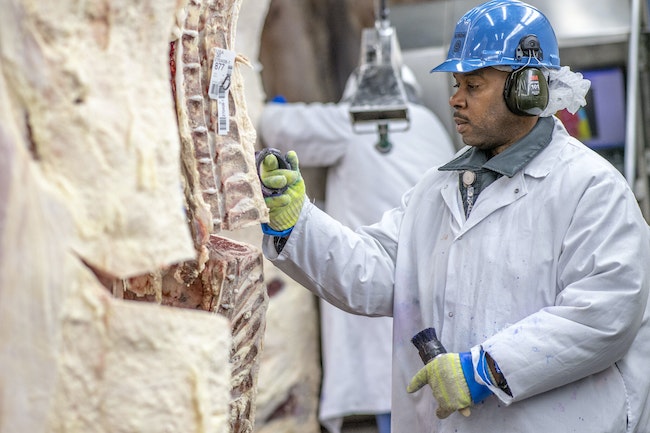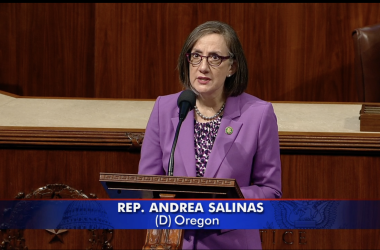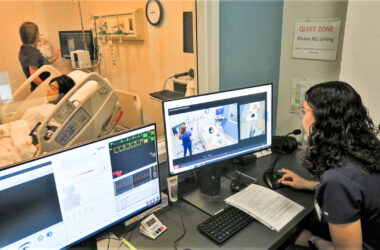
U.S. Department of Agriculture meat inspectors and graders at work. (Preston Keres/USDA/Flickr)
Oregon meat eaters are likely to have access to more local beef and other products and at cheaper prices with a new program that will localize meat inspections.
The program will expand the state’s processing capacity, allowing the Oregon Department of Agriculture to inspect meat that’s produced and sold within the state. Before, only the U.S. Department of Agriculture could conduct such inspections. But it’s had a shortage of inspectors, especially during the pandemic, giving Oregon ranchers limited options for processing meat from their livestock. Oregon has 13 USDA facilities, and they’re booked years out.
On July 28, the USDA gave the Oregon Department of Agriculture the ability to start its own testing program, as long as the standards equal those of the federal agency.
The change makes Oregon one of 28 states with its own meat inspection program and the first on the West Coast to have one. State Sens. Jeff Merkley and Ron Wyden, both Democrats, said in a statement they pushed federal U.S. Agriculture Secretary Tom Vilsack for months to approve the request for its own program. Merkley called it a win for producers and Oregonians who’ve faced soaring high meat prices.
“This approval will help Oregon farmers and ranchers process their livestock locally and provide affordable food,” Merkley said.
There are 12,000 livestock ranchers in Oregon, and in 2019 they exported $90 million worth of beef and veal products according to the state Agriculture Department and federal data.
Todd Nash, president of the Oregon Cattlemen’s Association, said ranchers suffered during the pandemic with few options for slaughter and processing.
“Oregon should be a fairly secure state, but we saw how vulnerable we are,” Nash said.
Alice Morrison, a manager at Friends of Family Farmers, which represents small producers, said some ranchers have to drive for hours to a USDA approved facility in Oregon or Idaho.
“We’ve known there’s been a bottleneck in processing options for small producers for a decade or so and the pandemic really busted that right open,” she said.
Farming and ranching groups have pushed for the change for years.
“There are 36 counties in the state and only 13 facilities,” Nash said. “It’s easy to do the math. And some of these counties are really large. Malheur, Lake, Harney County, there’s a lot of cattle but there are very few facilities.”
In February, the Legislature allocated $2 million toward helping meat processors pay for infrastructure upgrades and expansions to increase operating capacity. “There (were) $15 million worth of viable requests,” Nash said.
He’ll keep pushing for more funding in the next session as more processing facilities open. So will Morrison.
“We’ll be doing our utmost to see more money in a similar grant fund,” she said.
When the news about the new state inspection program came out, Morrison was in a Friends of Family Farmers meeting. She said people started cheering.
“This is the beginning of some real help,” Morrison said.
Gilliam County rancher Tom Rietmann said in a statement that expanding meat processing in the state will lower producers’ expenses and greenhouse gas emissions.
“In my situation, having more timely access to processing would have saved me thousands of dollars this year. Better access to meat processing facilities is a win-win for everyone,” he said.
Oregon Capital Chronicle is part of States Newsroom, a network of news bureaus supported by grants and a coalition of donors as a 501c(3) public charity. Oregon Capital Chronicle maintains editorial independence. Contact Editor Lynne Terry for questions: [email protected]. Follow Oregon Capital Chronicle on Facebook and Twitter.
STORY TIP OR IDEA? Send an email to Salem Reporter’s news team: [email protected].

Alex Baumhardt has been a national radio producer focusing on education for American Public Media since 2017. She has reported from the Arctic to the Antarctic for national and international media, and from Minnesota and Oregon for The Washington Post. She previously worked in Iceland and Qatar and was a Fulbright scholar in Spain where she earned a master's degree in digital media. She's been a kayaking guide in Alaska, farmed on four continents and worked the night shift at several bakeries to support her reporting along the way.









